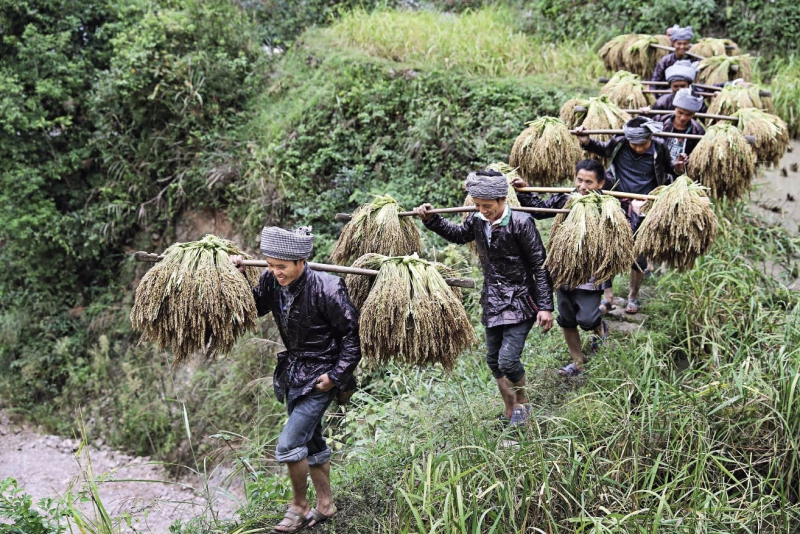___________
The clothing of each different group of Miao varies slightly. Generally speaking, there are two characteristics: the exquisite Miao embroideries, and ornate silver ornaments and headwear. These characteristics are particularly evident in Miao women’s clothing.

People of the Miao ethnic group sing and dance together in their traditional costumes to celebrate the neng yang, the first day of the new year in the Miao Calendar.
The artistic beauty of the Miao embroideries is best seen on their dress materials. Most of the clothes are hand-woven. Miao women learn to spin cotton and weave cloth at an early age from their elders, and the clothes they wear daily are mostly handmade. The making of the Miao clothing uses such basic traditional crafts as weaving, embroidery, and dying. These crafts are often combining to make the clothing more attractive.
When it comes to the colors of dress materials, the Miao people are fond of combining colors to present a strong contrast. Usually, red, black, white, yellow, and blue are among their favorites. In addition, they also attach great importance to the decorations on their clothing, especially embroideries.
There is a wide range of Miao embroidery. By color, it can be divided into monochrome embroidery and multi-color embroidery. Monochrome embroidery mainly uses green threads and is a craft producing elegant but simple results. The multi-color embroidery uses seven colors of silk threads to make more complex and diverse designs. To the Miao people, the clothes made of various embroideries is called “fineries,” and need to be stitched with many silver ornaments before becoming the final product. That’s why they are also called silver fineries.
The Miao embroidery often seeks inspiration from nature. Concrete patterns such as animals and plants are widely used, including flowers, fish, worms, cows, dogs, butterflies, dragons, and phoenixes. Besides these, abstract patterns such as geometric shapes or Chinese characters with auspicious meanings are also favored, to represent people’s desires and good wishes. Different seasons, plants, and animals can also appear in a design at the same time, forming a unique composition with rich colors, showing the pursuit of happiness and a good life.

Miao men walk across the fields carrying glutinous rice straws on a pole hung over their shoulders, a kind of conventional farm work.
Apart from being unique, the embroidery reflects the wisdom of the Miao people, and is seen as a manifestation of their history worn on human forms.
Miao clothing can be divided into formal and casual. The former are complicated, and artistic, and are worn on big occasions such as festival celebrations or wedding ceremonies. They are the representatives of Miao clothing. The latter are simpler, and are worn in everyday life.
Men’s casual clothes include three categories: jackets with buttons at the left of the front, jackets with buttons in the middle of the front, and long coats with buttons at the left of the front. Among them, the second type is more usually seen. For trousers, men often wear wide-leg pants. Women’s casual clothes include jackets with buttons at the right of the front and jackets with round collars and buttons at both sides of the front. Women often wear various pleated skirts and wide-leg pants.
Miao clothes also differ from region to region and for different age groups. Women’s clothes are more colorful and have as many as 100 varieties. In Miao villages, women’s clothes are always a delight to the eye.
Women’s shawls and pleated skirts are often embroidered with two horizontal patterns, one representing a yellow river and the other representing a clear river. It is said that it represents the ancestors of the Miao people who moved across a yellow river and a clear river to reach their final destination.
In their daily life, Miao women wrap checkered or cyan cloth scarves around their heads. When attending grand festivals, they will wear formal dresses with silver decorations and fine silver headwear 30 centimeters in height. When they walk, the silver pieces around their body clatter and make a pleasant sound. The front, back, sleeves, and hems of these garments are often stitched with a lot of square, rectangular, or semicircle silver pieces, and silver bells.
In addition, most Miao girls wear huge silver locks on their chests as the main decoration. Those silver locks are decorated with various patterns such as dragons, double lions, fish, butterflies, hydrangea, flowers, and plants. Silver chains, plates, and bells are attached beneath the locks. The silver locks are also called “long life locks,” or “silver protective collars.” Miao girls wear them from childhood, and they are intended to help bring health and auspiciousness. The locks are removed when a girl gets married.
In southeast Guizhou, there is also a custom of Miao men wearing silver jewelry. When dressed up, Miao men usually wear a cyan jacket with a patterned belt, a headscarf, a silver collar, and a silver chain or silver plate on the chest. If a man wears three silver collars, he is unmarried, and if he wears two, he is married.
The Miao people have a special preference for silver jewelry. In their eyes, the artifact can ward off evil spirits, and bring good luck and happiness. At the same time, silver jewelry is also a symbol of wealth. Some Miao girls are decorated with silver ornaments from head to toe, which can sometimes weigh up to 10 kilograms. The silver ornaments are of various types and peculiar shapes and are exquisitely crafted, making them a stand out in the clothing culture of China’s many ethnic groups.
___________
GUO ZHIDONG is a researcher of traditional culture at the No. 93 Courtyard Museum.